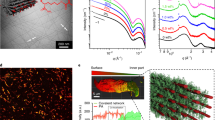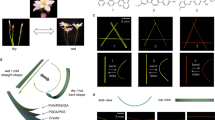Abstract
Actuators, as used in materials science, can improve soft robotics. Diverse stimuli have been utilized for actuation. Among the various stimuli, light has advantages for remote and local control. Mechanical properties are important factors to consider when evaluating the practical application of such materials in soft robotics. However, simultaneous studies on mechanical and actuating properties have rarely been conducted. We focus on 6,6-Nylon and supramolecular chemistry, particularly the chemistry between γ-cyclodextrin and azobenzene, to address this issue. Movable cross-links formed by cyclodextrin and azobenzene increase the mechanical toughness of this nylon-based material. The supramolecular material exhibits reversible photoresponsiveness in terms of both mechanical and actuating properties with mechanoisomerization. With predeformation, the actuation speed and work efficiency of the supramolecular material are drastically increased upon UV irradiation. We expect that supramolecular chemistry will contribute to material innovation for soft robotics.
This is a preview of subscription content, access via your institution
Access options
Subscribe to this journal
Receive 12 print issues and online access
$259.00 per year
only $21.58 per issue
Buy this article
- Purchase on Springer Link
- Instant access to full article PDF
Prices may be subject to local taxes which are calculated during checkout







Similar content being viewed by others
References
Li G, Chen X, Zhou F, Liang Y, Xiao Y, Cao X, et al. Self-powered soft robot in the Mariana Trench. Nature 2021;591:66–71.
Drotman D, Jadhav S, Sharp D, Chan C, Tolley MT. Electronics-free pneumatic circuits for controlling soft-legged robots. Sci Robot 2021;6:eaay2627.
Rothemund P, Kim Y, Heisser RH, Zhao X, Shepherd RF, Keplinger C. Shaping the future of robotics through materials innovation. Nat Mater. 2021;20:1582–7.
Kim J, Kim JW, Kim HC, Zhai L, Ko HU, Muthoka RM. Review of Soft Actuator Materials. Int J Precis Eng Manuf. 2019;20:2221–41.
Ma M, Guo L, Anderson DG, Langer R. Bio-inspired polymer composite actuator and generator driven by water gradients. Science. 2013;339:186–9.
Arazoe H, Miyajima D, Akaike K, Araoka F, Sato E, Hikima T, et al. An autonomous actuator driven by fluctuations in ambient humidity. Nat Mater. 2016;15:1084–9.
Ware TH, McConney ME, Wie JJ, Tondiglia VP, White TJ. Voxelated liquid crystal elastomers. Science. 2015;347:982–4.
Acome E, Mitchell SK, Morrissey TG, Emmett MB, Benjamin C, King M, et al. Hydraulically amplified self-healing electrostatic actuators with muscle-like performance. Science. 2018;359:61–5.
Kanik M, Orguc S, Varnavides G, Kim J, Benavides T, Gonzalez D, et al. Strain-programmable fiber-based artificial muscle. Science. 2019;365:145–50.
Kim HJ, Paquin L, Barney CW, So S, Chen B, Suo Z, et al. Low-Voltage Reversible Electroadhesion of Ionoelastomer Junctions. Adv Mater. 2020;32:2000600.
Burnworth M, Tang L, Kumpfer JR, Duncan AJ, Beyer FL, Fiore GL, et al. Optically healable supramolecular polymers. Nature. 2011;472:334–7.
Hartley GS. The Cis-form of Azobenzene. Nature. 1937;140:281.
Bandara HMD, Burdette SC. Photoisomerization in different classes of azobenzene. Chem Soc Rev. 2012;41:1809–25.
Soberats B, Uchida E, Yoshio M, Kagimoto J, Ohno H, Kato T. Macroscopic photocontrol of ion-transporting pathways of a nanostructured imidazolium-based photoresponsive liquid crystal. J Am Chem Soc. 2014;136:9552–5.
Crespi S, Simeth NA, König B. Heteroaryl azo dyes as molecular photoswitches. Nat Rev Chem. 2019;3:133–46.
Hada M, Yamaguchi D, Ishikawa T, Sawa T, Tsuruta K, Ishikawa K, et al. ya, Hayashi, Y., Kato, T. Ultrafast isomerization-induced cooperative motions to higher molecular orientation in smectic liquid-crystalline azobenzene molecules. Nat Commun. 2019;10:4159.
Ciamician G, Silber P. Chemische Lichtwirkungen. Ber der Dtsch Chem Ges. 1902;35:4128–31.
Trenor SR, Shultz AR, Love BJ, Long TE. Coumarins in polymers: From light harvesting to photo-cross-linkable tissue scaffolds. Chem Rev. 2004;104:3059–77.
Chandross EA. Photolytic Dissociation of Dianthracene. J Chem Phys. 1965;43:4175–6.
Bouas-Laurent H, Castellan A, Desvergne JP, Lapouyade R. Photodimerization of anthracenes in fluid solution: Structural aspects. Chem Soc Rev. 2000;29:43–55.
Yoshizawa M, Catti L. Bent Anthracene Dimers as Versatile Building Blocks for Supramolecular Capsules. Acc Chem Res. 2019;52:2392–404.
Carothers WH, Berchet GJ. Studies on polymerization and ring formation. VIII. amides from ϵ-aminocaproic acid. J Am Chem Soc. 1930;52:5289–91.
Haines CS, Li N, Spinks GM, Aliev AE, Di J, Baughman RH. New twist on artificial muscles. Proc Natl Acad Sci USA. 2016;113:11709–16.
Mirvakili SM, Hunter IW. Multidirectional Artificial Muscles from Nylon. Adv Mater. 2017;29:1604734.
Kim K, Cho KH, Jung HS, Yang SY, Kim Y, Park JH, et al. Double Helix Twisted and Coiled Soft Actuator from Spandex and Nylon. Adv Eng Mater. 2018;20:1800536.
Kim H, Moon JH, Mun TJ, Park TG, Spinks GM, Wallace GG, et al. Thermally Responsive Torsional and Tensile Fiber Actuator Based on Graphene Oxide. ACS Appl Mater Interfaces. 2018;10:32760–4.
Wu L, Jung De Andrade M, Saharan LK, Rome RS, Baughman RH, Tadesse Y. Compact and low-cost humanoid hand powered by nylon artificial muscles. Bioinspiration Biomim. 2017;12:026004.
Feringa BL. The Art of Building Small: From Molecular Switches to Motors (Nobel Lecture). Angew Chem Int Ed. 2017;56:11060–78.
Sauvage JP. From Chemical Topology to Molecular Machines (Nobel Lecture). Angew Chem Int Ed. 2017;56:11080–93.
Stoddart JF. Mechanically Interlocked Molecules (MIMs)—Molecular Shuttles, Switches, and Machines (Nobel Lecture). Angew Chem Int Ed. 2017;56:11094–125.
Dattler D, Fuks G, Heiser J, Moulin E, Perrot A, Yao X, et al. Design of Collective Motions from Synthetic Molecular Switches, Rotors, and Motors. Chem Rev. 2020;120:310–433.
Rekharsky MV, Inoue Y. Complexation thermodynamics of cyclodextrins. Chem Rev. 1998;98:1875–917.
Schmidt BVKJ, Barner-Kowollik C. Dynamic Macromolecular Material Design—The Versatility of Cyclodextrin-Based Host–Guest Chemistry. Angew Chem Int Ed. 2017;56:8350–69.
Nakahata M, Takashima Y, Harada A. Highly Flexible, Tough, and Self-Healing Supramolecular Polymeric Materials Using Host-Guest Interaction. Macromol Rapid Commun. 2016;37:86–92.
Park J, Murayama S, Osaki M, Yamaguchi H, Harada A, Matsuba G, et al. Extremely Rapid Self-Healable and Recyclable Supramolecular Materials through Planetary Ball Milling and Host–Guest Interactions. Adv Mater. 2020;32:2002008.
Harada A, Takashima Y, Nakahata M. Supramolecular Polymeric Materials via Cyclodextrin–Guest Interactions. Acc Chem Res. 2014;47:2128–40.
Yamaguchi H, Kobayashi Y, Kobayashi R, Takashima Y, Hashidzume A, Harada A. Photoswitchable gel assembly based on molecular recognition. Nat Commun. 2012;3:603.
Takashima Y, Hatanaka S, Otsubo M, Nakahata M, Kakuta T, Hashidzume A, et al. Expansion-contraction of photoresponsive artificial muscle regulated by host-guest interactions. Nat Commun. 2012;3:1270.
Tamesue S, Takashima Y, Yamaguchi H, Shinkai S, Harada A. Photoswitchable supramolecular hydrogels formed by cyclodextrins and azobenzene polymers. Angew Chem Int Ed. 2010;49:7461–4.
Iwaso K, Takashima Y, Harada A. Fast response dry-type artificial molecular muscles with [c2]daisy chains. Nat Chem. 2016;8:625–32.
Takashima Y, Hayashi Y, Osaki M, Kaneko F, Yamaguchi H, Harada A. A Photoresponsive Polymeric Actuator Topologically Cross-Linked by Movable Units Based on a [2]Rotaxane. Macromolecules. 2018;51:4688–93.
Ikejiri S, Takashima Y, Osaki M, Yamaguchi H, Harada A. Solvent-Free Photoresponsive Artificial Muscles Rapidly Driven by Molecular Machines. J Am Chem Soc. 2018;140:17308–15.
Osaki M, Ito K, Ikemoto Y, Yamaguchi H, Chujo Y, Harada A, et al. Photoresponsive polymeric actuator cross-linked by an 8-armed polyhedral oligomeric silsesquioxane. Eur Polym J. 2020;134:109806.
Okumura Y, Ito K. The polyrotaxane gel: A topological gel by figure-of-eight cross-links. Adv Mater. 2001;13:485–7.
Ikura R, Park J, Osaki M, Yamaguchi H, Harada A, Takashima Y. Supramolecular Elastomers with Movable Cross-Linkers Showing High Fracture Energy Based on Stress Dispersion. Macromolecules. 2019;52:6953–62.
Ikura R, Ikemoto Y, Osaki M, Yamaguchi H, Harada A, Takashima Y. Preparation of hydrophilic polymeric materials with movable cross-linkers and their mechanical property. Polymer. 2020;196:122465.
Liu C, Morimoto N, Jiang L, Kawahara S, Noritomi T, Yokoyama H, et al. Tough hydrogels with rapid self-reinforcement. Science. 2021;372:1078–81.
Harada A, Li J, Kamachi M. Double-stranded inclusion complexes of cyclodextrin threaded on poly(ethylene glycol). Nature. 1994;370:126–8.
Shimpuku C, Ozawa R, Sasaki A, Sato F, Hashimoto T, Yamauchi A, et al. Selective glucose recognition by boronic acid azoprobe/γ-cyclodextrin complexes in water. Chem Commun. 2009;1709–11.
Morgan PW, Kwolek SL. The nylon rope trick: Demonstration of condensation polymerization. J Chem Educ. 1959;36:182–4.
Szymański W, Beierle JM, Kistemaker HAV, Velema WA, Feringa BL. Reversible photocontrol of biological systems by the incorporation of molecular photoswitches. Chem Rev. 2013;113:6114–78.
Ishi-I T, Shinkai S. Dye-based organogels: Stimuli-Responsive Soft Materials Based on One-Dimensional Self-Assembling Aromatic Dyes. Top Curr Chem. 2005;258:119–60.
Shin J, Sung J, Kang M, Xie X, Lee B, Lee KM, et al. Light-triggered thermal conductivity switching in azobenzene polymers. Proc Natl Acad Sci USA. 2019;116:5973–8.
Gelebart AH, Jan Mulder D, Varga M, Konya A, Vantomme G, Meijer EW, et al. Making waves in a photoactive polymer film. Nature. 2017;546:632–6.
Surampudi SK, Patel HR, Nagarjuna G, Venkataraman D. Mechano-isomerization of azobenzene. Chem Commun. 2013;49:7519–21.
Acknowledgements
This research was funded by a grant for Scientific Research in an Innovative Area (JP19H05721) from MEXT, Japan. We also thank the Iketani Science and Technology Foundation (0341026-A), the Kao Foundation for Arts and Sciences, and the NAGASE Science Technology Foundation.
Author information
Authors and Affiliations
Corresponding author
Ethics declarations
Conflict of interest
The authors declare no competing interests.
Additional information
Publisher’s note Springer Nature remains neutral with regard to jurisdictional claims in published maps and institutional affiliations.
Rights and permissions
About this article
Cite this article
Park, J., Tamura, H., Yamaguchi, H. et al. Supramolecular nylon-based actuators with a high work efficiency based on host–guest complexation and the mechanoisomerization of azobenzene. Polym J 54, 1213–1223 (2022). https://doi.org/10.1038/s41428-022-00666-4
Received:
Revised:
Accepted:
Published:
Issue Date:
DOI: https://doi.org/10.1038/s41428-022-00666-4



